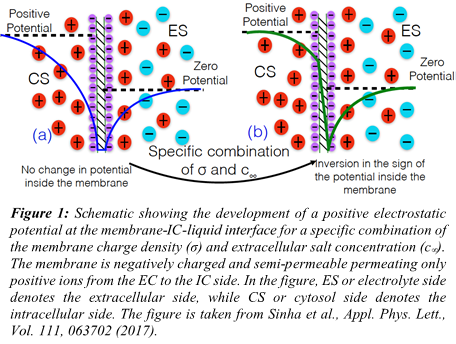|
A team of graduate students led by Mechanical Engineering Assistant Professor Siddhartha Das published new findings in the journal Applied Physics Letters earlier this week. This paper, written by Ph.D. students Shayandev Sinha and Haoyuan Jing, along with Das, explores the possibility of making the plasma membrane of a biological cell positive.
Plasma membrane is the outer membrane of a biological cell that protects the cell from external surroundings as well as keeps the contents of the cell intact. The plasma membrane typically consists of a phospholipid bilayer. The hydrophilic negatively-charged ends of the lipid molecules of this lipid bilayer face the intracellular (IC) and the extracellular (EC) liquids and ensure a negative surface charge density at the interface of the membrane with the IC and EC liquids. The phospholipid bilayer is impermeable to most species, such as ions, nutrients, etc.
However, protein channels on this plasma membrane support the exchange of ions, nutrients, and other substances between the IC and EC environments. These exchanges, dictated by the negative surface charges at the membrane-IC and membrane-EC liquid interfaces, allow for the survival of the cells and control of cellular signal transduction that eventually controls a host of activities of the cells. Of course, such protein-channel-mediated species exchange makes the membrane semi-permeable, i.e., it may allow some species to pass while not allowing others.
In this study, Das and his students demonstrated that a negatively charged semi-permeable plasma membrane permeating only positive ions from the EC to the IC side may develop a positive electrostatic potential at the membrane-IC-liquid interface under certain conditions of membrane surface charge density and concentration of the EC salt (see Fig. 1). The paper connects this occurrence to an uncommon situation where the IC liquid contains only counterions (i.e., ions of sign opposite to the membrane charge) leading to the development of a large negative gradient of the electrostatic potential across the chargeless membrane.
“We embark upon a most fascinating scenario where the membrane-IC-liquid interface has a negative charge density but a positive electrostatic potential,” Das notes of the findings. “Presence of a positive electrostatic potential would allow a cell to regulate entry and exit of ions in a manner hitherto unconceivable and may help to design novel drug delivery vehicles to cells or protect the cells better from the detrimental influence of toxic cations or stop the bacterial cells from secreting the damaging biofilms.”

Reference
S. Sinha. H. Jing, and S. Das, “Positive zeta potential of a negatively charged semi-permeable plasma membrane”, Appl. Phys. Lett. Vol. 111, 063702 (2017).
Related Articles:
ME Researchers Develop Methods to Mediate Nanoparticle Adhesion
UMD Researchers Discover Methods to Mediate Membrane-Nanoparticle Interactions
Exploration of Graphene's Wetting Dynamics Could Open New Possibilities in Fluid Mechanics of Two-Dimensional Materials
Drop-Drop Interactions on Soft Materials Unravel “Cheerios-Like” Behavior of Liquid Drops
Surface Physics driven Nanomanufacturing opens up new possibilities of synthesizing Metal Chalcogenides Nanostructures
Surfing Liquid Drops Shed New Light in Soft Materials Research
Das leads UMD undergraduate research team to publish cover article in Colloids and Surfaces B: Biointerfaces
August 11, 2017
|

